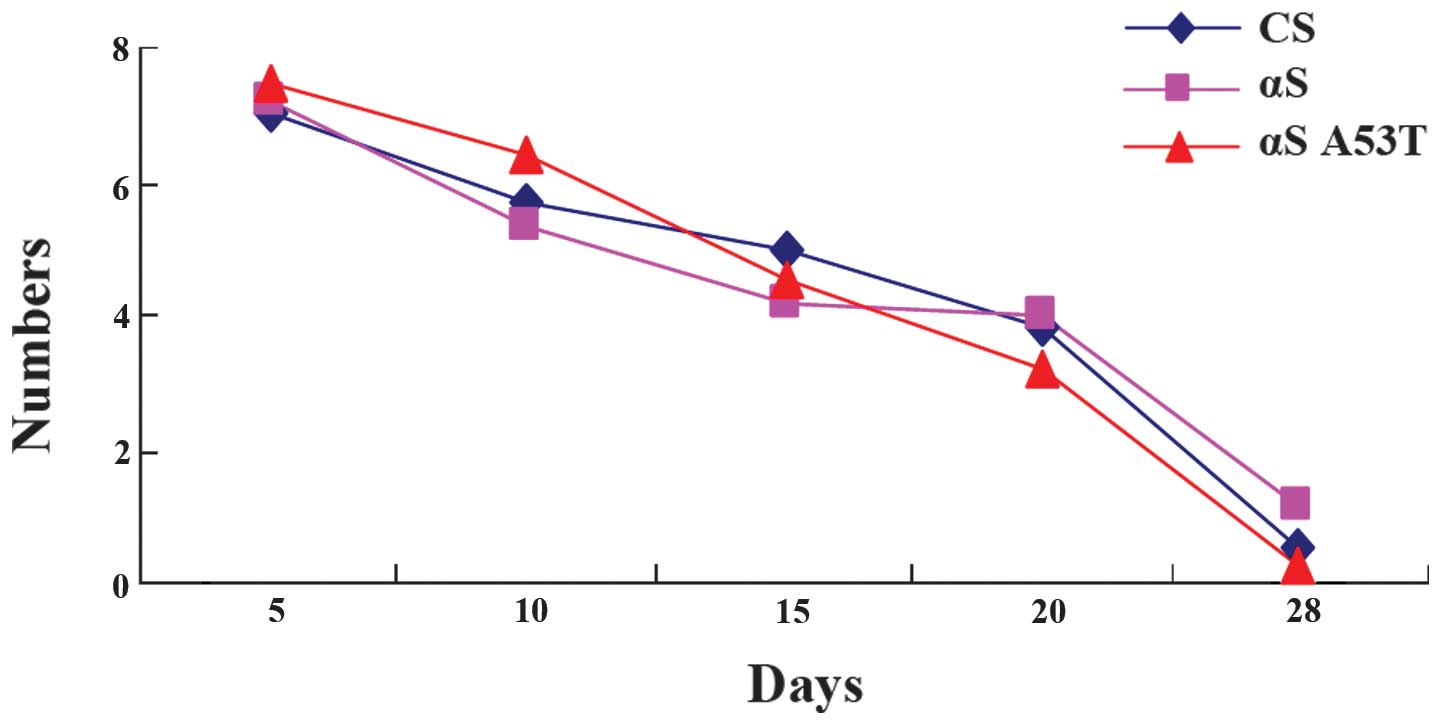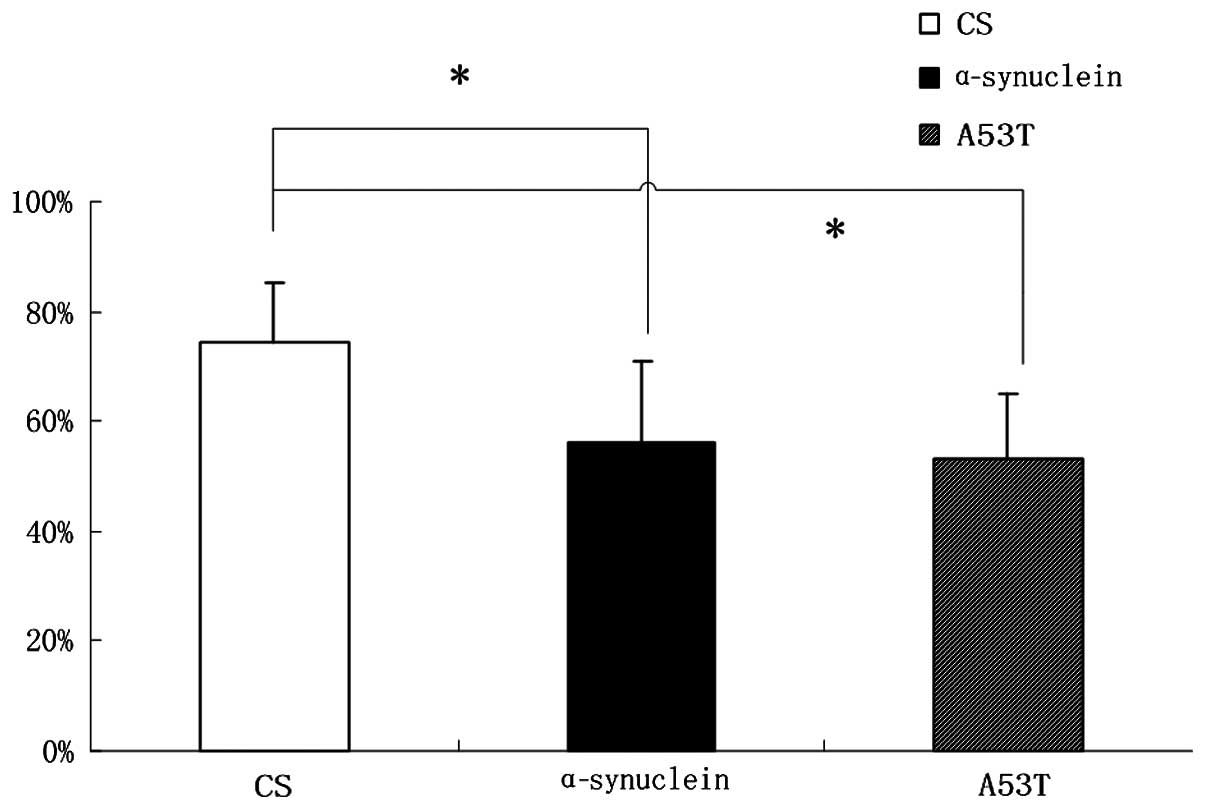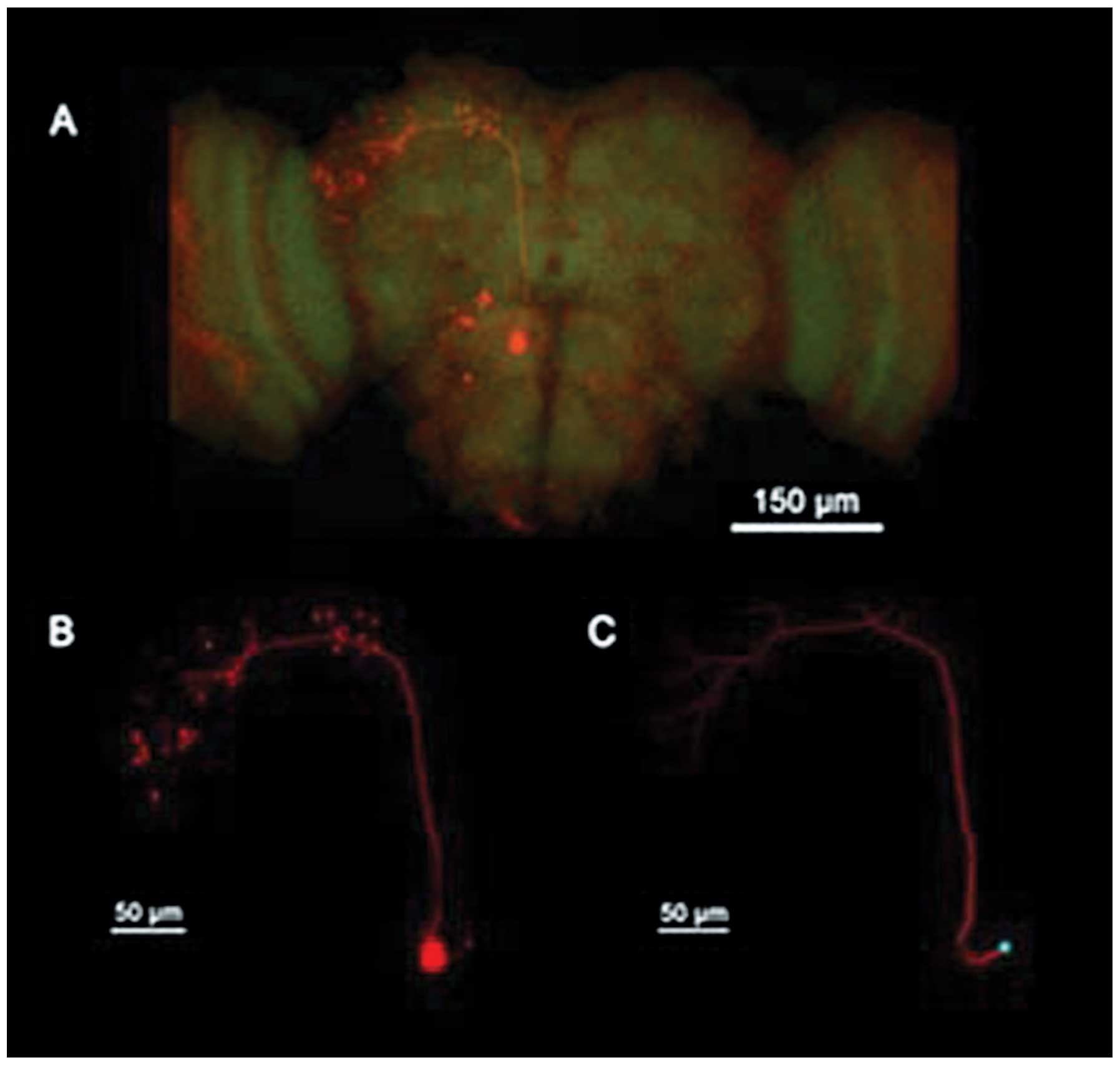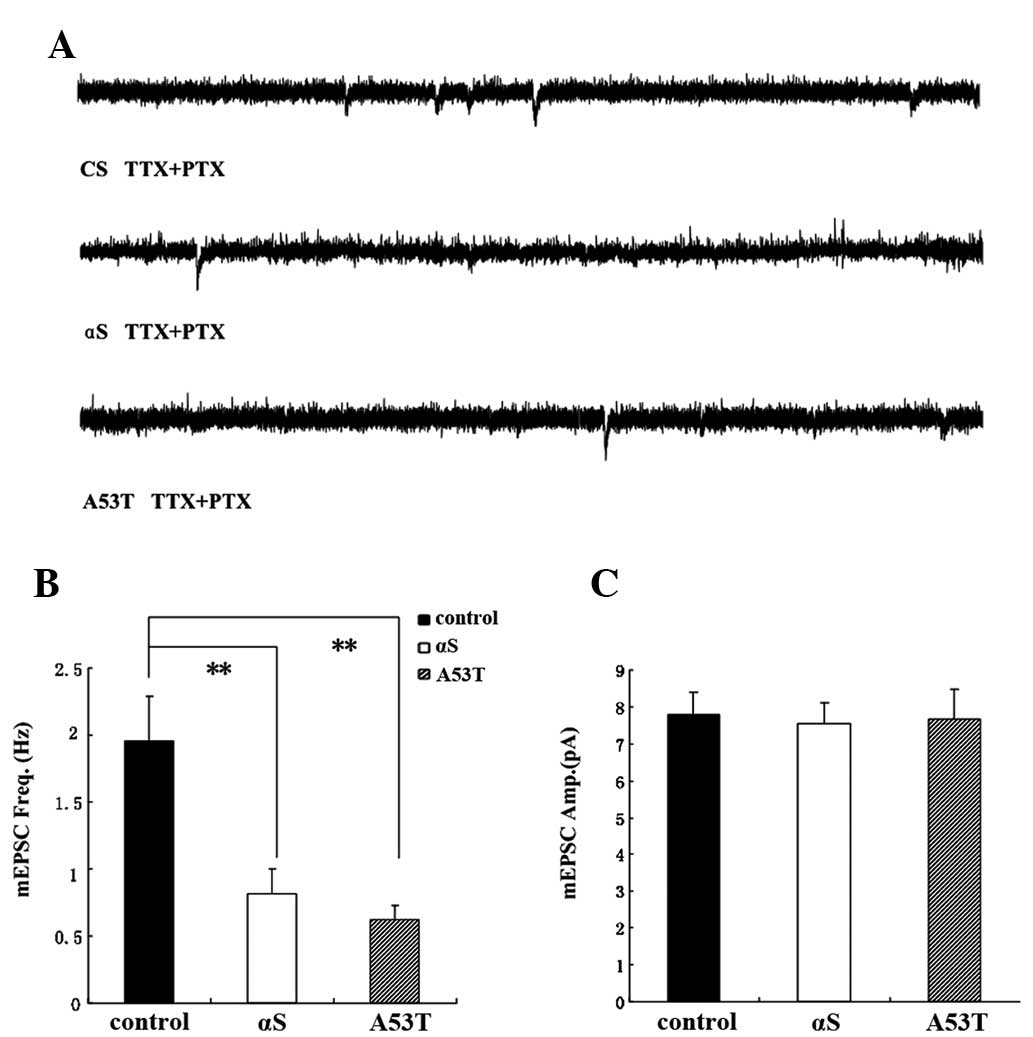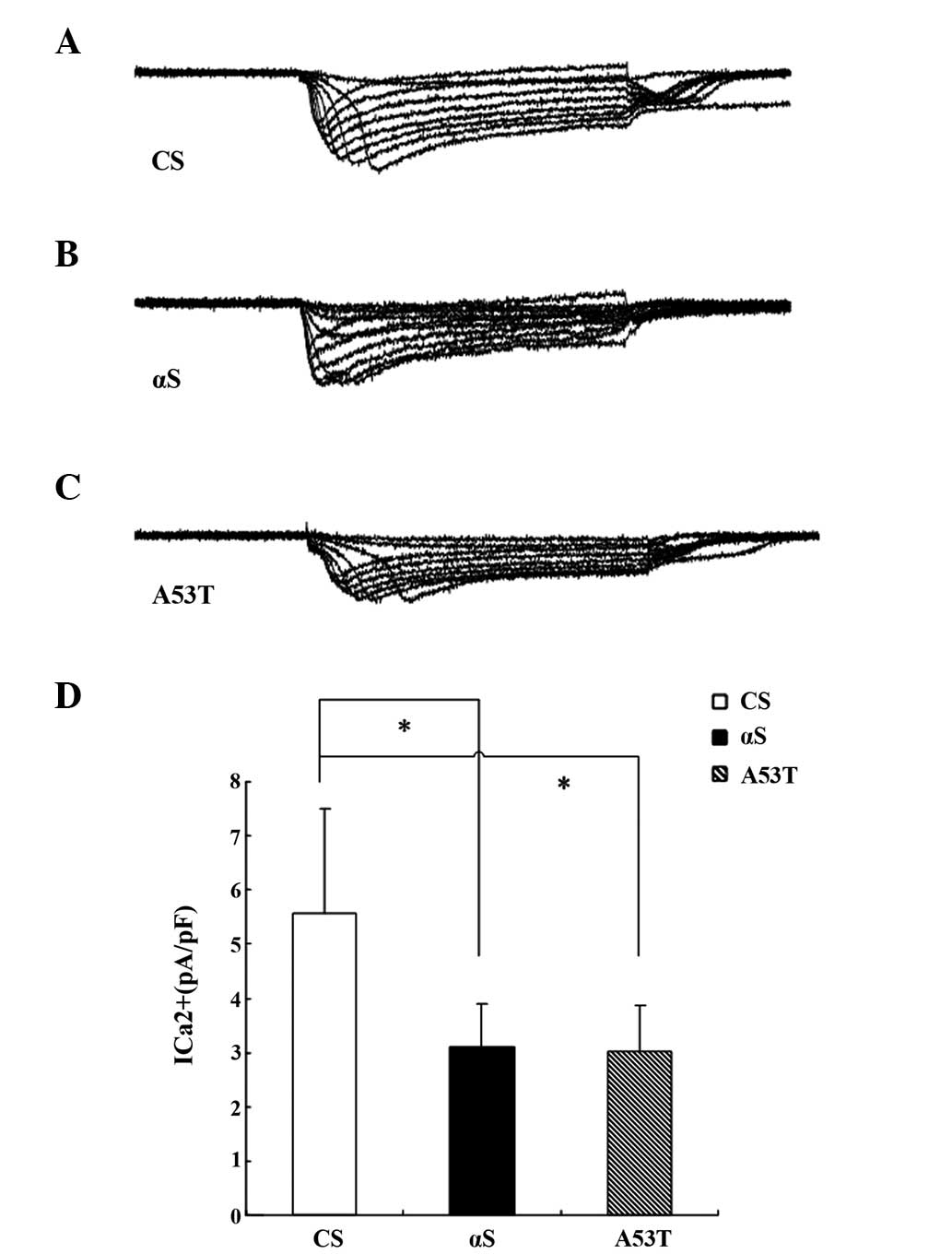Role of α‑synuclein in cognitive dysfunction: Studies in Drosophila melanogaster
- Authors:
- Published online on: May 8, 2015 https://doi.org/10.3892/mmr.2015.3763
- Pages: 2683-2688
Abstract
Introduction
Parkinson’s disease (PD) is one of the most common degenerative diseases of the nervous system. The major pathological change observed in PD is degeneration and necrosis of the dopaminergic neurons of the substantia nigra, which results in a decrease in dopamine synthesis (1). The low dopamine level disrupts the balance between the dopaminergic and cholinergic activity that is required for normal movement, which accounts for a series of clinical symptoms, including tremor, muscle stiffness and slowness of movement. Genetic and environmental factors contribute to this disease. While the majority of cases of PD are sporadic, certain cases occur as a result of genetic factors and are associated with certain gene mutations, including parkin (2), α-synuclein (α-Syn) and leucine-rich repeat kinase 2 (3,4). Lewy bodies (LBs) are a common feature of hereditary and idiopathic PD. α-Syn, the main component of LBs, is encoded by SNCA. Point mutations in SNCA, such as A30P and A53T, may cause familial cases of PD (5,6). α-Syn misexpression has been experimentally demonstrated to mimic several aspects of PD in transgenic animals, including motor dysfunction, α-Syn aggregation and neurodegeneration (7–9). At present, several molecular mechanisms have been proposed to explain the causes of PD, including misfolding and aggregation of α-Syn, posttranslational modifications of α-Syn and oxidative stress (10).
In addition to motor dysfunction, numerous patients with PD have non-motor symptoms, including depression, sleep disorders, dementia, autonomic dysfunction, hyposmia and gastrointestinal symptoms (11). Previous investigations have demonstrated that a specific cholinergic neurotransmitter defect in patients with senile dementia contributed significant damage to cholinergic neurons. This observation suggests a close association between the cholinergic system and cognitive function in the human brain. As a critical cognitive function, memory has been used to demonstrate that synaptic plasticity in the Drosophila melanogaster mushroom body neurons is critical for learning and memory of olfactory stimuli (12). The projection neurons (PNs) in the antennal lobe of the mushroom body are cholinergic and neurotransmission at the synapse conducts messages in the form of electrical activity (13). Voltage-gated calcium channels (CAC) are located at the plasma membrane of nerve terminals and are crucial for the process of synaptic transmission and neuronal communication. Cav2-type calcium channels are encoded by cac and regulate action potential (AP)-independent neurotransmitter release at cholinergic synapses in the adult Drosophila brain (14). While certain details have been determined concerning the molecular mechanisms of PD, direct evidence for the association between α-Syn and cholinergic transmission remains to be demonstrated. The aim of the present study was to use Drosophila as a model organism to observe whether α-Syn affects cholinergic neuronal transmission and consequentially alters their learning and memory capabilities.
Materials and methods
Drosophila strains
Drosophila stocks were reared on standard cornmeal agar medium supplemented with dry yeast for 24 h at 60% relative humidity. α-Syn-expressing Drosophila were modified by microinjection and expression of A53T α-Syn transgenes was driven by the elav-GAL4 expression system. In brief, the α-Syn clone was constructed using the elav-GAL4 expression system, then this was injected into the eggs of white eye Drosophila (control flies). After hybridization of the red eye flies, α-Syn flies were created. Elav-GAL4 flies were crossed with UAS-A53T flies (provided by the Biochemistry and Cell Institute of Shanghai Life Science Research Institute of the Chinese Academy of Sciences, Shanghai, China), to produce the A53T flies.
Western blot analysis
The cerebral proteins of α-Syn Drosophila brains were extracted from tissue lysate with the protease inhibitor phenylmethylsulfonyl fluoride (Sigma-Aldrich, St. Louis, MO, USA). The solution was sonicated and ultracentrifuged for 30 min at 4695 × g at below 4°C. The resulting supernatant was boiled for 15 min in a water bath. Adult fly heads of the appropriate genotypes were prepared and analyzed using standard SDS-PAGE with 10% Tris-glycine gradient gels. The primary α-Syn antibody (cat. no. 610786) was developed by BD Biosciences (Mountain View, CA, USA) and was diluted to 1:1,000 prior to use. The goat anti-mouse secondary antibody (cat. no. 81-6511; Thermo Fisher Scientific, San Francisco, CA, USA) was then diluted to 1:10,000 and applied, and an X-ray film exposure was conducted.
Climbing assays
Flies were divided into random groups of 20–30 individuals per vial and then assessed for geotaxis as described previously (8). Briefly, groups of 10 flies were placed in a 95×27 mm empty vial. Flies were gently taped to the bottom of the vial and the number of flies crossing an 8 cm mark was recorded after 10 sec. Researchers were blinded to the corresponding genotype and condition of the flies.
T maze test
Hungry flies (80–100), which had been in the dark for 30 min prior to the experiment were placed in the maze. After 90 sec, smell A was released in one side of the T maze and at the same time, twelve 1.5 sec of the 70 volt DC electrical stimulation was applied over 60 sec. Flies were then allowed to breathe air for 45 sec. Subsequently, smell B was released for 60 sec in the other side of the T maze followed by 45 sec air. The flies were then allowed to move around the maze freely for 2 min, after which the numbers of flies at the sides of the maze with smells A and B were counted.
Immunofluorescence
The flies brains were stripped and placed on a slide. The slide was rinsed with 1% PBS (Sigma-Aldrich) three times, blocked and incubated in a blocking buffer (0.1 M PBS, 0.1% Triton X-100 and 1% BSA; Sigma-Aldrich) for 3 h at room temperature. The α-synuclein antibody (1:250; 610786; BD Biosciences) was then applied and washed by PBS for 5 min, three times. Subsequently, the rabbit anti-human IgG secondary antibody (BA1020; Boster, Wuhan, China) was applied. Following incubation, the brain was washed three times with PBS with 5 min intervals and fixed with a coverslip. The brains of flies were observed with an immunofluorescence laser scanning confocal microscope (Zeiss LSM710; Carl Zeiss, Oberkochen, Germany).
Biocytin staining and immunohistochemistry images
In order to identify and confirm that the cells recorded were PNs, cells recorded were stained by biocytin (Sigma-Aldrich). While recording, cells were injected with biocytin through a recording pipette filled with internal solution containing biocytin in whole-cell recording mode for a minimum of 30 min. After recording, the brains were collected and fixed in 4% formaldehyde (Sigma-Aldrich) in phosphate-buffered saline (PBS; Sigma-Aldrich) at 4°C for 10 h. The brain was then rinsed in 1% PBS three times, blocked and incubated in a blocking buffer (0.1 M PBS, 0.1% Triton X-100, and 1% bovine serum albumin; Sigma-Aldrich) containing streptavidin-Cy3 (Molecular Devices Ltd., Wokingham, UK) for 3 h at room temperature. After incubation, the brain was washed three times with 5 min intervals in PBS. A BX51WI microscope (Olympus, Tokyo, Japan) with a ×40 objective and confocal camera was used to capture images of dendritic arborization of the PNs in the antennal lobe.
Immunohistochemistry
Adult Drosophila brains were fixed in 4% paraformaldehyde and embedded in paraffin. The paraffin-embedded brains were then cut into sections. The α-Syn antibody (1:250; BD Biosciences) was used to detect the expression of α-Syn.
Electrophysiological recordings from PNs in isolated whole brain
All brains were obtained from female flies two days prior to eclosion. The entire brain, including optic lobes, was removed from the head and prepared for recordings in standard external solution containing 20 U/ml papain (Sigma-Aldrich) with 1 mM l-cysteine. Subsequently, the dissected brains were mounted in an RC-26 perfusion chamber (Sigma-Aldrich) containing the recording solution bubbled with 95% O2 and 5% CO2 (2 ml/min) throughout the experiments, with the ventral surface of the brain facing up. Pipettes were targeted to PNs in the dorsal neuron cluster in the antennal lobe. For measurements of cholinergic miniature excitatory postsynaptic currents (mEPSCs), tetrodotoxin (TTX; 1 μM) was added to the external solution to block voltage-gated sodium currents and γ-aminobutyric (GABA)ergic synaptic currents, and picrotoxin (PTX; 10 μM; Sigma-Aldrich) was added to block GABAergic synaptic currents. CaCl2 was omitted and tetraethylammonium (TEA; 10 mM; Sigma-Aldrich) and 4-aminopyridine (4-AP; 1 mM) were added to the external solution to measure Ca2+ currents. For Ca2+ current measurements, the external solution consisted of 101 mM NaCl, 1.8 mM CaCl2, 0.8 mM MgCl2, 5.4 mM KCl, 5 mM glucose, 1.25 mM NaH2PO4, 20.7 mM NaHCO3, 1 μM TTX, 10 mM TEA and 1 mM 4-AP.
Statistical analysis
Statistical analysis was conducted using SPSS software, version 11.5 (SPSS, Inc., Chicago, IL, USA) Comparison of the magnitude of the calcium currents prior to and following application of permethrin was made using an unpaired t-test. Comparison of the area below the baseline of sodium currents prior to and following application of permethrin was made using a paired t-test. Comparisons of more than two treatments were made with analysis of variance (ANOVA) and the Bonferroni post hoc correction.
Results
Expression of α-Syn protein
The pan-neuronal driver elav-GAL4 was used to drive expression of normal and mutant (A53T) human α-Syn throughout the nervous system. Western blot analysis was performed to verify the expression of α-Syn (Fig. 1).
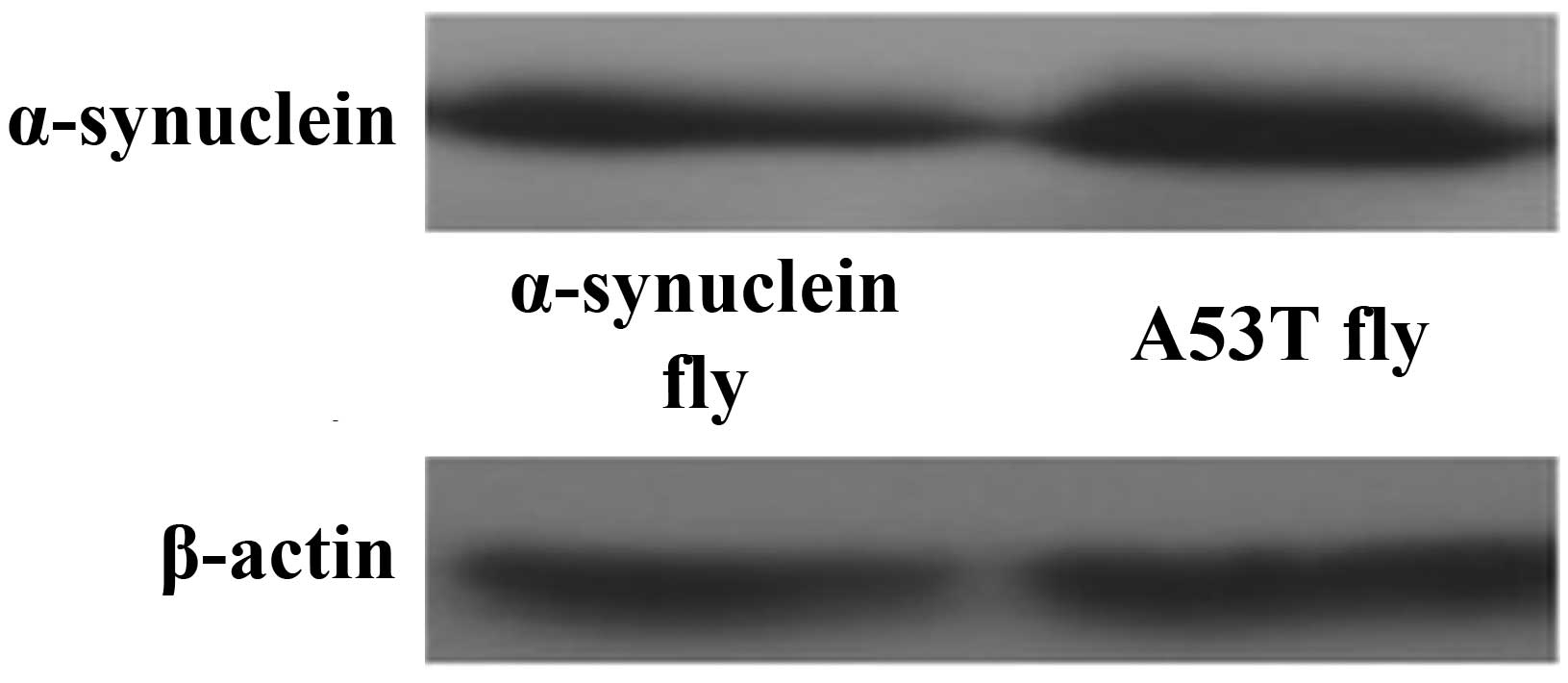 | Figure 1Western blot analysis of Drosophila α-synuclein. Protein of α-synuclein and A53T are 19 kDa. |
No differences are present in locomotor ability of α-Syn Drosophila
Previous studies have demonstrated that a decrease in the ability of flies to climb up the wall of a plastic vial is associated with the progression of the pathology in PD (15,16). However, in the present study, no significant decrease in climbing ability was observed (Fig. 2).
Learning and memory skills are reduced in α-Syn Drosophila
Compared with CS flies, the learning and memory ability of α-Syn wild-type and A53T mutation flies decreased exhibiting a reduction of ~18% (Fig. 3) as elucidated through a T maze experiment.
Immunofluorescence analysis of α-Syn in Drosophila
The whole brain of the Drosophila were observed with an immunofluorescence laser scanning confocal microscopy, and it was identified that the levels of green fluorescence were greater in the α-Syn Drosophila compared with the control saline group. In addition, green fluorescence was particularly evident in the mushroom body (Fig. 4).
mEPSC frequency is decreased in α-Syn Drosophila
Previous studies have demonstrated that cac-encoded voltage-gated calcium channels are important in regulating the spontaneous release of neurotransmitter at excitatory cholinergic synapses and mEPSC frequency in the PNs of Drosophila (7,17,18). Recordings were performed at room temperature for a minimum of 1 min in the presence of TTX to block sodium channels and PTX to block GABA receptors. The dorsal antennal lobe glomeruli is the location of the PNs, with two main branches projecting to the lateral horn and the local mushroom body. The PNs were identified morphologically from biocytin fills and their specific electrical activities (Fig. 5). The PNs were selected for analysis as they were cholinergic and cholinoceptive. PNs firing spontaneously were recorded in α-Syn Drosophila in the presence of TTX and PTX. The experiments indicated that the frequency of PNs was reduced. Sodium AP-independent mEPSCs in the antennal lobe PNs were monitored in the whole brain, which was isolated from female fly pupae two days prior to eclosion. mEPSCs were directly monitored by whole cell patch-clamp recordings from PNs. The average mEPSC frequency was 1.92±0.3 Hz under normal conditions. The average mEPSC frequency decreased significantly by 0.62±0.11 Hz in the α-Syn Drosophila. The present results demonstrated that the mEPSC frequency in the α-Syn Drosophila was decreased (Fig. 6).
Cholinergic mEPSCs were recorded from single PNs following the addition of TTX and PTX to the external solution. The mean frequency of mEPSCs was significantly reduced by α-Syn (ANOVA, Bonferroni post hoc test; P<0.01). No significant difference was identified between the mean mEPSC amplitude of the α-Syn and A53T groups and that of the CS group.
Calcium currents of PNs in brains of α-Syn Drosophila pupae two days prior to eclosion
Calcium currents have been revealed to have broad effects on neuronal function, particularly in presynaptic terminals for neurotransmitter release, electrical excitability and activity-dependent gene regulation (19,20). Calcium currents were directly calculated in antennal lobe PNs isolated from the whole brain of fly pupae two days prior to eclosion. Using whole cell voltage-clamp recordings, the inward calcium current was isolated in PNs as previously described (21). The average calcium current in normal PNs and α-Syn PNs were 5.57±1.94 and 3.03±0.85 pA/pF, respectively (Fig. 7).
Discussion
Drosophila are an ideal model for investigating the association between PD and Alzheimer’s disease (AD) as transgenic techniques can be used to express human α-Syn in the CNS of Drosophila. The abundant expression of acetylcholine and GABA throughout the Drosophila CNS suggested that these classic neurotransmitters have a major role in mediating fast synaptic transmission (22). The PNs were selected for analysis as they are cholinergic and cholinoceptive, receiving cholinergic synaptic input from olfactory receptor neurons and potentially lateral excitatory input (13). The preparations used in the current study and described in a previous study (23) allowed assessment of the cholinergic synaptic transmission in PNs in an isolated whole brain. Cholinergic currents were recorded using a whole-cell patch clamp at room temperature following treatment with TTX for at least 1 min to block sodium channels and PTX to block GABA receptors. The neurons were identified as cholinergic and mediated by nicotinic acetylcholine receptors based on the finding that the majority of the mEPSCs recorded could be inhibited by a competitive antagonist of the nicotinic acetylcholine receptor at the neuromuscular junction termed curare, which is classified as a long-duration (24), non-depolarizing neuromuscular blocking agent. A number of studies have revealed that the morbidity associated with senile dementia is more prevalent in PD patients and cholinergic neurons exhibit a critical role in AD. A number of studies had reported difficulties in recording cholinergic currents in the mammalian nervous system and as a result and in addition to their amenability to transgenic studies, Drosophila became a useful model for studying of the association between AD and PD.
Certain non-motor symptoms of PD, including cognitive impairment and sleep disorders often appear a number of years prior to the onset of motor symptoms. The main pathology associated with PD involves dopaminergic degeneration, which is the main factor contributing to the motor symptoms. The motor symptoms observed in patients with PD are often accompanied by cognitive impairment, depression and other symptoms associated with degeneration of the forebrain. Mutations in α-Syn are associated with genetic and sporadic cases of PD. Previous studies have demonstrated that an α-Syn mutation in Drosophila, which leads to increased oligomerization, enhances the degree of neurotoxicity in the fruit fly (25). A previous study demonstrated that there is a long time period between the degeneration of dopaminergic neurons and the appearance of the typical motor symptoms of PD (26), which indicates that there is a compensatory mechanism in the central nervous system. It is hypothesized that the dynamic balance between dopamine and acetylcholine is important. Inhibiting the cholinergic system may cause a decline in learning and memory abilities and symptoms similar to senile amnesia (27). In addition, numerous patients with PD eventually develop cognitive deficits and dementia (28). The present experiments demonstrate that the non-motor symptoms in patients with PD may be associated with the cholinergic system.
The present results also demonstrate that learning and memory skills reduced in α-Syn wild-type and A53T mutant Drosophila by ~18%. Previous studies have demonstrated that the expression of human α-Syn may impair the motor capability of Drosophila (8,29,30). However, in the present study, no significant difference was identified in the motor function of the α-Syn and A53T Drosophila. It is possible that the flies in the present study were too young and the expression of α-Syn may only effect non-motor symptoms at this stage, without a marked impact on motor symptoms. α-Syn may reduce the frequency of mEPSCs in PNs and reduce the electrical signals of the calcium channel. Thus, it has been demonstrated that α-Syn expression in Drosophila may affect cholinergic synaptic transmission. The frequency of mEPSCs in PNs and the calcium current were reduced, which may be associated with the decline in the ability to learn and in memory in Drosophila. The present study demonstrated that mutations in α-Syn may be one of the reasons for the higher incidence of senile dementia in patients with PD. However, the exact mechanism requires further investigation.
References
|
Janezic S, Threlfell S, Dodson PD, et al: Deficits in dopaminergic transmission precede neuron loss and dysfunction in a new Parkinson model. Proc Natl Acad Sci USA. 110:E4016–E1025. 2013. View Article : Google Scholar : PubMed/NCBI | |
|
Kitada T, Asakawa S, Hattori N, Matsumine H, Yamamura Y, Minoshima S, et al: Mutations in the parkin gene cause autosomal recessive juvenile parkinsonism. Nature. 392:605–608. 1998. View Article : Google Scholar : PubMed/NCBI | |
|
Paisán-Ruiz C, Jain S, Evans EW, Gilks WP, Simòn J, van der Brug M, et al: Cloning of the gene containing mutations that cause PARK8-linked Parkinson’s disease. Neuron. 44:595–600. 2004. View Article : Google Scholar | |
|
Zimprich A, Biskup S, Leitner P, Lichtner P, Farrer M, Lincoln S, et al: Mutations in LRRK2 cause autosomal-dominant parkinsonism with pleomorphic pathology. Neuron. 44:601–607. 2004. View Article : Google Scholar : PubMed/NCBI | |
|
Krüger R, Kuhn W, Müller T, et al: Ala30Pro mutation in the gene encoding α-synuclein in Parkinson’s disease. Nature Genetics. 18:106–108. 1998. View Article : Google Scholar | |
|
Polymeropoulos MH, Lavedan C, Leroy E, et al: Mutation in the α-synuclein gene identified in families with Parkinson’s disease. Science. 276:2045–2047. 1997. View Article : Google Scholar : PubMed/NCBI | |
|
Feany MB and Bender WW: A Drosophila model of Parkinson’s disease. Nature. 404:394–398. 2000. View Article : Google Scholar : PubMed/NCBI | |
|
Lee MK, Stirling W, Xu Y, et al: Human α-synuclein-harboring familial Parkinson’s disease-linked Ala-53→Thr mutation causes neurodegenerative disease with α-synuclein aggregation in transgenic mice. Proc Nat Acad Sci USA. 99:8968–8973. 2002. View Article : Google Scholar | |
|
Masliah E, Rockenstein E, Veinbergs I, et al: Dopaminergic loss and inclusion body formation in α-synuclein mice: implications for neurodegenerative disorders. Science. 287:1265–1269. 2000. View Article : Google Scholar : PubMed/NCBI | |
|
Mizuno H, Fujikake N, Wada K, et al: α-Synuclein transgenic Drosophila as a model of Parkinson’s disease and related synucleinopathies. Parkinsons Dis. 2011:2127062011. | |
|
Chaudhuri KR, Yates L and Martinez-Martin P: The non-motor symptom complex of Parkinson’s disease: A comprehensive assessment is essential. Curr Neurol Neurosci Rep. 5:275–283. 2005. View Article : Google Scholar : PubMed/NCBI | |
|
Heisenberg M: Mushroom body memoir: from maps to models. Nat Rev Neurosci. 4:266–275. 2003. View Article : Google Scholar : PubMed/NCBI | |
|
Kazama H and Wilson RI: Homeostatic matching and nonlinear amplification at identified central synapses. Neuron. 58:401–413. 2008. View Article : Google Scholar : PubMed/NCBI | |
|
Bosboom JL, Stoffers D and Wolters ECh: Cognitive dysfunction and dementia in Parkinson’s disease. J Neural Transm. 111:1303–1315. 2004. View Article : Google Scholar : PubMed/NCBI | |
|
Rieckhof GE, Yoshihara M, Guan Z and Littleton JT: Presynaptic N-type calcium channels regulate synaptic growth. J Biol Chem. 278:41099–41108. 2003. View Article : Google Scholar : PubMed/NCBI | |
|
Pendleton RG, Parvez F, Sayed M and Hillman R: Effects of pharmacological agents upon a transgenic model of Parkinson’s disease in Drosophila melanogaster. J Pharmacol Exp Ther. 300:91–96. 2002. View Article : Google Scholar | |
|
Stone E, Haario H and Lawrence JJ: A kinetic model for the frequency dependence of cholinergic modulation at hippocampal GABAergic synapses. Math Biosci. 258:162–175. 2014. View Article : Google Scholar : PubMed/NCBI | |
|
Zhaowei L, Yongling X, Jiajia Y and Zhuo Y: The reduction of EPSC amplitude in CA1 pyramidal neurons by the peroxynitrite donor SIN-1 requires Ca2+ influx via postsynaptic non-L-type voltage gated calcium channels. Neurochem Res. 39:361–371. 2014. View Article : Google Scholar : PubMed/NCBI | |
|
Gu H, Jiang SA, Campusano JM, Iniguez J, Su H, Hoang AA, et al: Cav2-type calcium channels encoded by cac regulate AP-independent neurotransmitter release at cholinergic synapses in adult Drosophila brain. J Neurophysiol. 101:42–53. 2009. View Article : Google Scholar : | |
|
Kawasaki F, Zou B, Xu X and Ordway RW: Active zone localization of presynaptic calcium channels encoded by the cacophony locus of Drosophila. J Neurosci. 24:282–285. 2004. View Article : Google Scholar : PubMed/NCBI | |
|
Catterall WA: Structure and regulation of voltage-gated Ca2+ channels. Annu Rev Cell Dev Biol. 16:521–555. 2000. View Article : Google Scholar | |
|
Karpinar DP, Balija MBG, Kügler S, et al: Pre-fibrillar α-synuclein variants with impaired β-structure increase neurotoxicity in Parkinson’s disease models. EMBO J. 28:3256–3268. 2009. View Article : Google Scholar : PubMed/NCBI | |
|
Rascol O, Payoux P, Ory F, et al: Limitations of current Parrkinson’s disease therapy. Ann Neuro. 53:s3–s15. 2003.discussions 12–5. View Article : Google Scholar | |
|
Restifo LL and White K: Molecular and genetic approaches to neurotransmitter and neuromodulator systems in Drosophila. Adv Insect Physiol. 22:115–219. 1990. | |
|
Gu H and O’Dowd DK: Cholinergic synaptic transmission in adult Drosophila Kenyon cells in situ. J Neurosci. 26:265–272. 2006. View Article : Google Scholar : PubMed/NCBI | |
|
Thompson MA: Muscle relaxant drugs. Br J Hosp Med. 23:1531980.PubMed/NCBI | |
|
Rinne JO, Myllykylä T, Lönnberg P and Marjamäki P: A postmortem study of brain nicotinic receptors in Parkinson’s and Alzheimer’s disease. Brain Res. 547:167–170. 1991. View Article : Google Scholar : PubMed/NCBI | |
|
Foltynie T, Brayne CE, Robbins TW and Barker RA: The cognitive ability of an incident cohort of Parkinson’s patients in the UK. The CamPaIGN study. Brain. 127:550–560. 2004. View Article : Google Scholar | |
|
Chen AY, Wilburn P, Hao X and Tully T: Walking deficits and centrophobism in an α-synuclein fly model of Parkinson’s disease. Genes Brain Behav. 13:812–820. 2014. View Article : Google Scholar : PubMed/NCBI | |
|
Gajula Balija MB, Griesinger C, Herzig A, Zweckstetter M and Jäckle H: Pre-fibrillar α-synuclein mutants cause Parkinson’s disease-like non-motor symptoms in Drosophila. PLoS One. 6:e247012011. View Article : Google Scholar |



